Cellular respiration
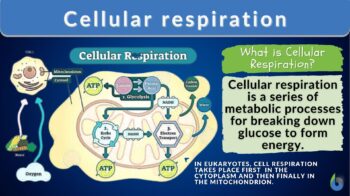
Cellular respiration n. ˈsɛljʊlə ɹɛspɪˈɹeɪʃən Definition: A series of metabolic processes that take place within a cell in which the biochemical energy is harvested from organic substance (e.g. glucose) and then stored in energy-carrying biomolecule (e.g. ATP) for use in energy-requiring activities of the cell
Table of Contents

Cellular Respiration Definition
What is cellular respiration in simple terms? Cellular respiration can be defined simply as a series of metabolic processes that take place within a cell . Biochemical energy is harvested from organic substances (e.g. glucose, a six-carbon molecule) and then stored in energy-carrying biomolecules (e.g. adenosine triphosphate or ATP) for use in the energy-requiring activities of the cell. The main function of cellular respiration is to break down glucose to form energy.
Cellular Respiration Overview
Cellular respiration takes place in the cells of all living organisms. What does cellular respiration produce? Cellular respiration produces energy, which is vital because the energy is used to maintain life . The process is carried out by both prokaryotic and eukaryotic cells .
Cellular respiration location
Where does cellular respiration take place? In prokaryotic cells, it is carried out in the cell cytoplasm , in eukaryotic cells it begins in the cytosol and then is carried out in the mitochondria . In eukaryotes, the 4 stages of cellular respiration include glycolysis , transition reaction (pyruvate oxidation), the Krebs cycle (also known as the citric acid cycle), and oxidative phosphorylation through the electron transport chain .
How does cellular respiration work?
Cellular respiration works either in the presence or absence of oxygen . But essentially, the process is called cellular respiration because the cell seems to “ respire ” in a way that it takes in molecular oxygen (as an electron acceptor) and releases carbon dioxide (as an end product). Hence, the process is described as aerobic .
When the final electron acceptor is not oxygen, it is described as anaerobic . An anaerobic type of respiration is carried out chiefly by anaerobic organisms (e.g. anaerobic bacteria) that use certain molecules as electron acceptors instead of oxygen.
In another anaerobic process, such as fermentation , pyruvate is not metabolized in the same way as an aerobic type of respiration.
The pyruvate molecules produced are not transported into the mitochondria. Rather, they remain in the cytoplasm where they can be turned into a waste product that will be removed from the cell.
Why is cellular respiration important?
The main function of cellular respiration is to synthesize biochemical energy. Cellular respiration is essential to both eukaryotic and prokaryotic cells because this biochemical energy is produced to fuel many metabolic processes, such as biosynthesis, locomotion, and transportation of molecules across membranes.
For the specific products of cellular respiration: jump to the section – What are the Products of Cellular Respiration? For the cellular respiration diagram, see the next section below.
The Location of Cellular Respiration
Cellular respiration takes place in both the cytosol and mitochondria of cells. Glycolysis takes place in the cytosol, whereas pyruvate oxidation, the Krebs cycle, and oxidative phosphorylation occur in the mitochondrion. Figure 1 shows the locations of the main biochemical reactions involved in cellular respiration.
:max_bytes(150000):strip_icc():format(webp)/cellular_respiration-8fcc3f1ad3e54a828dabc02146ce4307.jpg)
The energy produced by the mitochondria is stored as potential energy in molecules called adenosine triphosphate (ATP). The main chemical produced in cellular respiration is ATP. ATP is the standard unit in which the energy released during respiration is stored. The mitochondrion can be recognized as the “ powerhouse ” of the cell because of its major role in cellular respiration. Mitochondria contain a number of enzymes to aid in this process.
These organelles contain 2 membranes – an outer membrane and an inner membrane . The space in between these membranes is known as the intermembrane space . The outer membrane contains many proteins known as porins and is permeable to molecules and ions (e.g. ATP). The inner membrane contains complexes involved in the electron transport chain stage of cellular respiration which will be described in more detail below.
If cellular respiration takes place in the presence of oxygen, it is known as aerobic respiration . If it takes place in the absence of oxygen, it is known as anaerobic respiration .
Enzyme-catalyzed reactions are responsible for breaking down organic molecules (usually carbohydrates or fats). During these enzyme reactions, a small amount of energy is channeled into molecules of ATP.
ATP is found in every living cell and can relocate energy wherever it is needed. Energy can be released from ATP by its dephosphorylation to adenosine diphosphate (ADP). See Figure 2 for the structure of ATP.
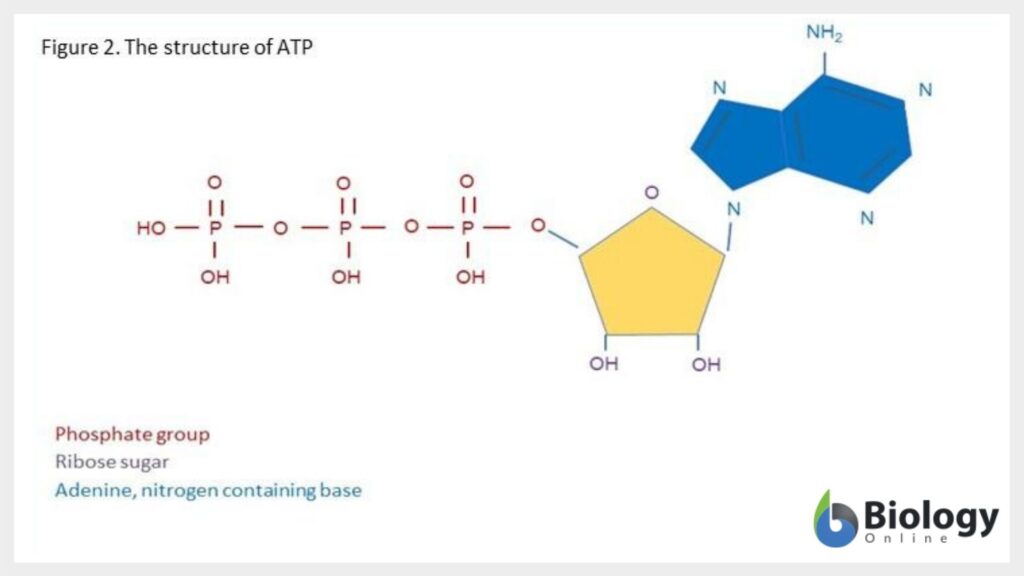
What is the Role of Oxygen in Cellular Respiration?
Oxygen is used in cellular respiration. It is a diatomic molecule (i.e. it is formed of two oxygen molecules joined by a covalent bond) and it is electronegative, meaning it attracts bonding pairs of electrons. As it pulls electrons towards it, it releases energy from the chemical bonds. Potential energy from our food is combined with oxygen and creates products of carbon dioxide (CO 2 ) and water (H 2 O) which releases energy to form the molecule ATP.
For example, the monosaccharide glucose , (the most basic form of carbohydrate) can be combined with oxygen. The high-energy electrons that are found in the glucose are transferred to the oxygen and potential energy is released. The energy is stored in the form of ATP. This final process of cellular respiration takes place on the inner membrane of the mitochondria. Instead of all the energy being released at once, the electrons go down the electron transport chain.
The energy is released in small pieces and that energy is used to form ATP. See below to understand more about the stages of cellular respiration including the electron transport chain.
Forum Question: How many water molecules are produced by cellular respiration? Featured Answer !
Cellular Respiration Equations
Cellular respiration can be written as chemical equations. An example of the aerobic respiration equation is in Figure 3.

As for chemical equations for anaerobic cellular respiration , see the diagrams below:
- Lactic acid fermentation equation

- Alcoholic fermentation equation

Types of Cellular Respiration
Below are examples of aerobic respiration and anaerobic cellular respiration : lactic acid fermentation and alcoholic fermentation .
Aerobic respiration
Most prokaryotes and eukaryotes use the process of and undergo aerobic respiration. As mentioned above, it is the process of cellular respiration in the presence of oxygen. Water and carbon dioxide are the end products of this reaction along with energy. (See Figure 3)
Lactic Acid Fermentation
In lactic acid fermentation, 6 carbon sugars, such as glucose are converted into energy in the form of ATP. However, during this process, lactate is also released, which in solution becomes lactic acid. See Figure 4 for an example of a lactic acid fermentation equation. It can occur in animal cells (such as muscle cells) as well as some prokaryotes. In humans, the lactic acid build-up in muscles can occur during vigorous exercise when oxygen is not available. The aerobic respiration pathway is switched to the lactic acid fermentation pathway in the mitochondria which although produces ATP; it is not as efficient as aerobic respiration. The lactic acid build-up in muscles can also be painful.
Alcoholic Fermentation
Alcoholic fermentation (also known as ethanol fermentation) is a process that converts sugars into ethyl alcohol and carbon dioxide. It is carried out by yeast and some bacteria. Alcoholic fermentation is used by humans in the process of making alcoholic drinks such as wine and beer. During alcoholic fermentation, sugars are broken down to form pyruvate molecules in a process known as glycolysis. Two molecules of pyruvic acid are generated during the glycolysis of a single glucose molecule. These pyruvic acid molecules are then reduced to two molecules of ethanol and two molecules of carbon dioxide. The pyruvate can be transformed into ethanol under anaerobic conditions where it begins by converting into acetaldehyde, which releases carbon dioxide, and acetaldehyde is converted into ethanol. In alcoholic fermentation, the electron acceptor NAD+ is reduced to form NADH and this exchange of electrons helps to generate ATP. Figure 5 shows an alcoholic fermentation equation.
Methanogenesis
Methanogenesis is a process only carried out by anaerobic bacteria. These bacteria belong to the phylum Euryarchaeota and they include Methanobacteriales, Methanococcales, Methanomicrobiales, Methanopyrales, and Methanosarcinales. Methanogens only occur in oxygen-depleted environments, such as sediments, aquatic environments, and in the intestinal tracts of mammals. There are 3 pathways for methanogenesis:
(1) Acetoclastic Methanogenesis. This process involves activating acetate into acetyl-coenzyme A (acetyl-CoA), from which a methyl group is then transferred into the central methanogenic pathway. Acetoclastic methanogens split acetate in the following way:
CH 3 COOH (Acetate) –> CO 2 (Carbon dioxide) + CH 4 (methane)
Acetoclastic methanogenesis is performed by Methanosarcina and Methanosarcinales and is most often found in freshwater sediments. Here, it is thought that acetate contributes to around two-thirds of the total methane formation on Earth on an annual basis.
(2) Methylotrophic Methanogenesis. In methylotrophic methanogenesis, methanol or methylamines serve as the substrate instead of acetate. This process can be observed in marine sediments where methylated substrates can be found. Some acetoclastic methanosarcinales and at least one member of the Methanomicrobiales can also use this second pathway.
(3) Hydrogenotrophic Methanogenesis. Finally, hydrogenotrophic methanogenesis is a process that is used by Methanobacteriales, Methanococcales, Methanomicrobiales, Methanopyrales, and Methanosarcinales (i.e. all five orders). In this reaction, hydrogenotrophic methanogens use hydrogen for the reduction of carbon dioxide, carbon monoxide, or formate according to the following:
4H 2 (Hydrogen) + CO 2 (Carbon dioxide) –> CH 4 (Methane) + 2H 2 O (Water)
Although methanogenesis is a type of respiration, an ordinary electron transport chain is not used. Methanogens instead rely on several coenzymes, including coenzyme F420, which is involved in the activation of hydrogen, and coenzyme M, which is involved in the terminal reduction of CH3 groups to methane (Figure 6.).
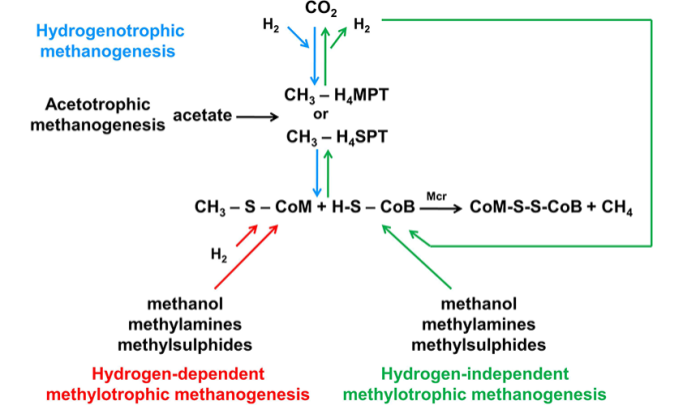
Steps of Cellular Respiration
What are the 4 stages of cellular respiration? There are 4 stages of the cellular respiration process. These are Glycolysis, the transition reaction, the Krebs cycle (also known as the citric acid cycle), and the electron transport chain with chemiosmosis. What does cellular respiration produce? Let’s find out in each of the steps of cellular respiration.
The literal meaning of glycolysis is ‘splitting sugar’. Glykos comes from the Greek word ‘sweet’ and lysis means ‘to split’. Glycolysis is a series of reactions that extract energy from glucose by splitting it into 2 molecules of pyruvate. Glycolysis is a biochemical pathway that evolved long ago and is found in the majority of organisms. In organisms that perform cellular respiration, glycolysis is the first stage of the process. However, glycolysis doesn’t require oxygen, and many anaerobic organisms also have this pathway.
Before glycolysis begins, glucose must be transported into the cell and phosphorylated. In most organisms, this occurs in the cytosol. The most common type of glycolysis is the Embden–Meyerhof–Parnas (EMP pathway), discovered by Gustav Embden, Otto Meyerhof, and Jakub Karol Parnas. Glycolysis does refer to other pathways, one such pathway described is the Entner–Doudoroff pathway. This article concentrates on the EMP pathway.
The Embden-Meyerhof-Parnas (EMP) pathway of glycolysis
The glycolysis pathway can be separated into two phases:
- The Investment Phase – ATP is consumed.
- The Pay Off Phase – ATP is produced.
Glycolysis takes place in 10 steps. See Figure 7. for a diagrammatic representation of glycolysis.
The enzyme hexokinase phosphorylates glucose using ATP to transfer a phosphate to the glucose molecule to form glucose-6-phosphate. This reaction traps the glucose within the cell.
Glucose-6-phosphate is isomerized into fructose-6-phosphate. This involves the change of an aldose into a ketose. The enzyme phosphoglucose isomerase catalyzes this reaction. A molecule of ATP provides the phosphate group.
Phosphofructokinase (PFK) with magnesium as a cofactor phosphorylates glucose-6-kinase to fructose 1,6-bisphosphate. This enzyme catalyzes the transfer of a phosphoryl group from ATP to fructose-6-phosphate. This reaction yields ADP and fructose 1, 6-bisphosphate.
The importance of phosphofructokinase (PFK)
PFK is a significant enzyme in the regulation of glycolysis. A high ratio of ADP to ATP will lead to the inhibition of PFK and therefore inhibit glycolysis. Adenosine monophosphate (AMP) is a positive regulator of PFK. When ATP levels are low, more ATP is generated by changing ADP molecules to ATP and AMP. When ATP levels are high, PFK is inhibited, thereby slowing down the process of glycolysis. Citric acid is also known to inhibit the action of PFK.
These first 3 stages of glycolysis have used up a total of 2 ATP molecules; hence it is known as the investment phase.
The enzyme aldolase is utilized to split fructose 1, 6-bisphosphate into glyceraldehyde-3-phosphate (GAP) and dihydroxyacetone phosphate (DHAP).
Triosephosphate isomerase reorganizes DHAP into GAP. GAP is the only molecule that continues in the glycolytic pathway. At this point there are two molecules of GAP, the next steps are to fully convert to pyruvate.
Firstly, GAP is oxidized by the coenzyme nicotinamide adenine dinucleotide (NAD) and then it is phosphorylated by the addition of a free phosphate group by the enzyme Glyceraldehyde-3-phosphate dehydrogenase (GAPDH). GAPDH has a form that enables it to hold the GAP in a conformation allowing the NAD molecule to pull hydrogen off it. This results in the conversion of NAD to NADH. The phosphate group then attacks the GAP molecule and releases it from the enzyme to yield 1,3 bisphosphoglycerate, NADH, and a hydrogen atom.
Phosphoglycerate kinase (PGK) with the help of magnesium converts 1,3 bisphosphoglycerate to 3-phosphoglycerate by removing a phosphate group. The phosphate is transferred to a molecule of ADP that yields a molecule of ATP.
Phosphoglycerate mutase rearranges the position of the phosphate group on 3-phosphoglycerate allowing it to become 2-phosphoglycerate.
2-phosphoglycerate is converted to phosphoenolpyruvate (PEP) by the enzyme enolase. Enolase dehydrates 2 phosphoglycerate molecules by removing water.
Finally, pyruvate kinase transfers a phosphate from PEP to ADP yielding ATP and pyruvate.

Transition reaction
In aerobic respiration, the transition reaction occurs in the mitochondria. Pyruvate moves out of the cytoplasm and into the mitochondrial matrix. In anaerobic conditions, pyruvate will stay in the cytoplasm and be used in lactic acid fermentation instead. The purpose of the transition reaction is to transfer pyruvate to acetyl CoA producing carbon dioxide and NADH. For every single molecule of glucose, 2 molecules of CO 2 and NADH are generated (Figure 8).
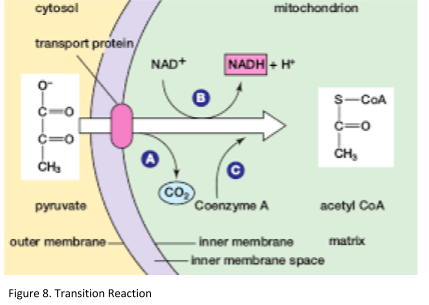
What is the Krebs cycle?
The Krebs cycle, also known as the citric acid cycle, was discovered by Hans Adolf Krebs in 1937. It can be described as a metabolic pathway that generates energy. This process happens in the mitochondrial matrix, where pyruvate has been imported following glycolysis. The final products of the Krebs cycle include 2 molecules of CO 2 , 3 molecules of NADH, 1 molecule of FADH 2 , and 1 molecule of GTP. These products are generated per single molecule of pyruvate. The products of the Krebs cycle power the electron transport chain and oxidative phosphorylation. Acetyl CoA enters the Krebs cycle after the transition reaction has taken place (conversion of pyruvate to acetyl CoA). See Figure 9. for the diagrammatic scheme of the Krebs cycle.
There are 8 steps in the Krebs cycle. Below are reviews of some of the principal parts of these steps and the products of the Krebs cycle:
Acetyl CoA joins with oxaloacetate releasing the CoA group and producing citrate, a six-carbon molecule. The enzyme involved in this process is citrate synthase.
Citrate is converted to isocitrate by the enzyme aconitase. This involves the removal and then the addition of water.
Firstly, the secondary OH group of isocitrate is oxidized by the coenzyme NAD+ and a ketone is formed. The ketone is then decarboxylated (i.e. CO 2 removed) by isocitrate dehydrogenase leaving behind alpha-ketoglutarate which is a 5-carbon molecule. Isocitrate dehydrogenase is central in regulating the speed of the Krebs cycle citric acid cycle.
Oxidative decarboxylation takes place by alpha-ketoglutarate dehydrogenase. This enzyme catalyzes the conversion of α-ketoglutarate to succinyl-CoA and produces NADH delivering electrons to the respiratory chain.
Succinyl-CoA is converted to succinyl phosphate, and then succinate. Succinate thiokinase (other names include succinate synthase and Succinyl coenzyme A synthetase), converts succinyl-CoA to succinate, and free coenzyme A. It also converts ADP to ATP or guanosine diphosphate (GDP) to guanosine triphosphate (GTP). Firstly, the coenzyme A in the succinyl group is substituted by a hydrogen phosphate ion. Succinyl phosphate then transfers its phosphoric acid residue to guanosine diphosphate (GDP) so that GTP and succinate are produced.
Succinate is oxidized to fumarate by succinate dehydrogenase. Flavin adenine dinucleotide (FAD) is the coenzyme bound to succinate dehydrogenase. FADH 2 is formed by the removal of 2 hydrogen atoms from succinate. This releases energy that is sufficient to reduce FAD. FADH remains bound to succinate dehydrogenase and transfers electrons directly to the electron transport chain. Succinate dehydrogenase performs this process inside the mitochondrial inner membrane which allows this direct transfer of the electrons.
L-malate is formed by the hydration of fumarate. The enzyme involved in this reaction is fumarase.
In the final step, L-malate is oxidized to form oxaloacetate by malate dehydrogenase. Another molecule of NAD+ is reduced to NADH during this process.
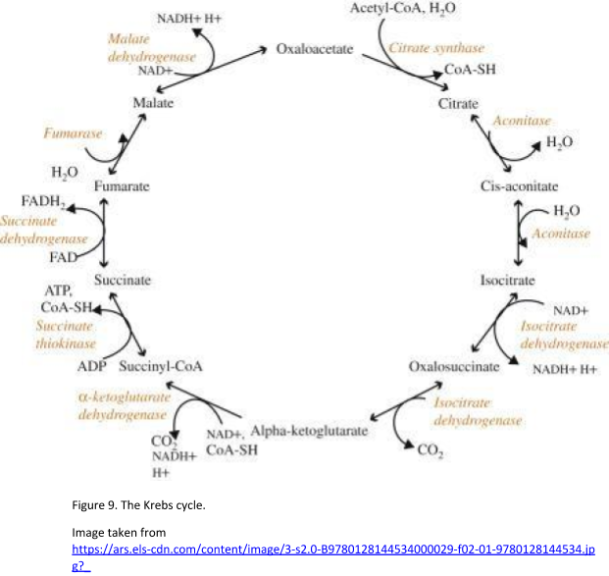
Electron transport chain and chemiosmosis
Where is oxygen used in cellular respiration? It is in the stage involving the electron transport chain. The electron transport chain is the final stage of cellular respiration. It occurs on the inner mitochondrial membrane and consists of several electron carriers.
The purpose of the electron transport chain is to form a gradient of protons that produces ATP. It moves electrons from NADH to FADH 2 to molecular oxygen by pumping protons from the mitochondrial matrix to the intermembrane space resulting in the reduction of oxygen to water.
Therefore, the role of oxygen in cellular respiration is the final electron acceptor. It is worth noting that the electron transport chain of prokaryotes may not require oxygen. Other chemicals including sulfate can be used as electron acceptors in the replacement of oxygen.
The complexes involved in the electron transport chain
Four protein complexes are involved in the electron transport chain. Complex I or NADH-ubiquinone oxidoreductase transfers electrons from NADH to Coenzyme Q (ubiquinone). Complex II or succinate dehydrogenase receives FADH 2 which is also found in the Krebs cycle. FADH 2 transfers its electrons to iron-sulfur proteins within complex II, which then pass the electrons to Coenzyme Q, as for complex I.
These electrons are then shuttled down the remaining complexes and proteins. These include complexes II, III, IV, cytochrome c, and coenzyme Q. They are passed into the inner mitochondrial membrane which slowly releases energy. The electron transport chain uses the decrease in free energy to pump hydrogen ions from the matrix to the intermembrane space in the mitochondrial membranes. This creates an electrochemical gradient for hydrogen ions.
The energy in this gradient is used to generate ATP from ADP and inorganic phosphate (Pi) via the ATP synthase complex. Overall, the end products of the electron transport chain are ATP and water. See Figure 10 for a summary of the electron transport chain.
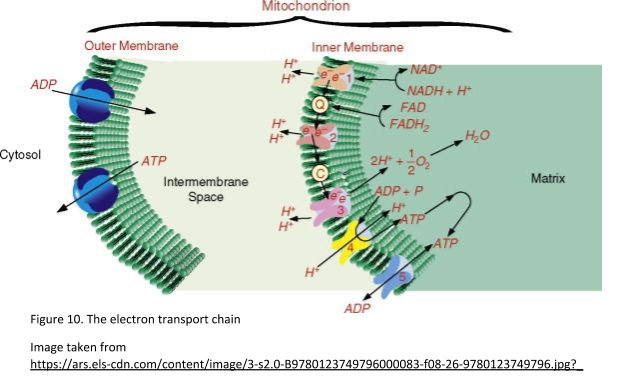
Chemiosmosis
The process described above in the electron transport chain in which a hydrogen ion gradient is formed by the electron transport chain is known as chemiosmosis . After the gradient is established, protons diffuse down the gradient through ATP synthase. The flow of hydrogens catalyzes the pairing of phosphate with ADP, forming ATP (Figure 11). Chemiosmosis was discovered by the British Biochemist, Peter Mitchell. In fact, he was awarded the Nobel Prize for Chemistry in 1978 for his work in this area and ATP synthesis.
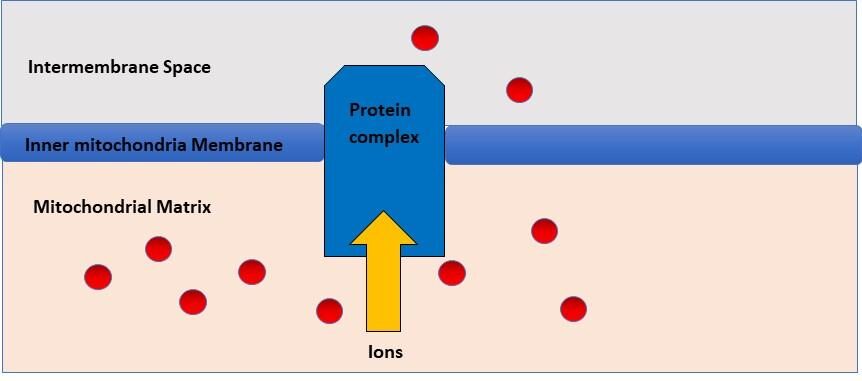
ATP production in cellular respiration
How much ATP is produced in aerobic respiration? What are the products of the electron transport chain? Glycolysis provides 4 molecules of ATP per molecule of glucose; however, 2 are used in the investment phase resulting in a net of 2 ATP molecules. 2 molecules of ATP are produced in the Krebs cycle. Finally, 34 molecules of ATP are produced in the electron transport chain (figure 12).
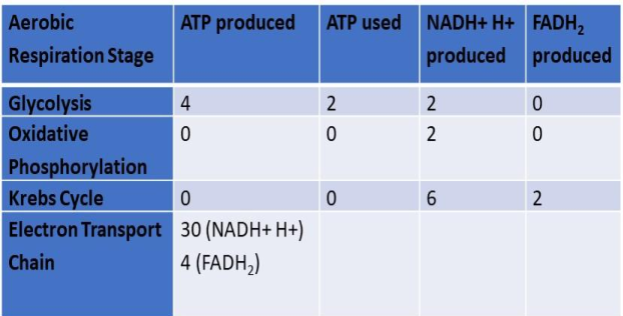
How much ATP is Produced in Fermentation?
Only 2 molecules of ATP are produced in fermentation. This occurs in the glycolysis phase of respiration. Therefore, it is much less efficient than aerobic respiration; it is, however, a much quicker process.
And so essentially, this is how in cellular respiration, energy is converted from glucose to ATP. And by glucose oxidation via the aerobic pathway, more ATPs are relatively produced.
Forum Question: Why is ATP considered as the energy currency? Why not GTP, CTP, or TTP ? Featured Answer !
Products of Cellular Respiration
What are the products of cellular respiration? The biochemical processes of cellular respiration can be reviewed to summarise the final products at each stage.
- During glycolysis, the initial reactants are glucose and 2 molecules of ATP, resulting in the end products of pyruvate, ATP, and NADH.
- During the transition reaction, the substrate pyruvate leads to the formation of the products CoA, NADH, and CO 2 .
- In the Krebs cycle, Acetyl CoA and oxaloacetate lead to the end products oxaloacetate, NADH, ATP, FADH 2 , and CO 2 .
- Finally, in the electron transport chain, stage of cellular respiration, NADH, FADH 2 , ADP, and phosphate are the substrates and the resulting products are NAD, FAD, and ATP.
Cellular Respiration Disorders
Mitochondrial dysfunction can lead to problems during oxidative phosphorylation reactions. This can be due to mutations of either the mitochondrial DNA or the nuclear DNA. These mutations can lead to protein deficiencies. For example, complex I mitochondrial disease is characterized by a shortage of complex I within the inner mitochondrial membrane. This leads to problems with brain function and movement for the individual affected. People with this condition are also prone to having high levels of lactic acid build-up in the blood which can be life-threatening. Complex I mitochondrial disease is the most common mitochondrial disease in children. To date, more than 150 different mitochondrial dysfunction syndromes have been described as related to problems with the oxidative phosphorylation process. Furthermore, there have been over 600 different point mutations in mitochondrial DNA as well as DNA rearrangements that are thought to be involved in various human diseases. There are many different studies ongoing by various research groups around the world looking into the different mutations of mitochondrial genes to give us a better understanding of conditions related to dysfunctional mitochondria.[a][b]
Purpose of Cellular Respiration
What is the purpose of cellular respiration? Different organisms have adapted their biological processes to carry out cellular respiration processes either aerobically or anaerobically dependent on their environmental conditions. The reactions involved in cellular respiration are incredibly complex involving an intricate set of biochemical reactions within the cells of the organisms. All organisms begin with the process of glycolysis in the cell cytoplasm, then either move into the mitochondria in aerobic metabolism to continue with the Krebs cycle and the electron transport chain or stay in the cytoplasm in anaerobic respiration to continue with fermentation (Figure 13). Cellular respiration is the process that enables living organisms to produce energy (ATP) for survival.
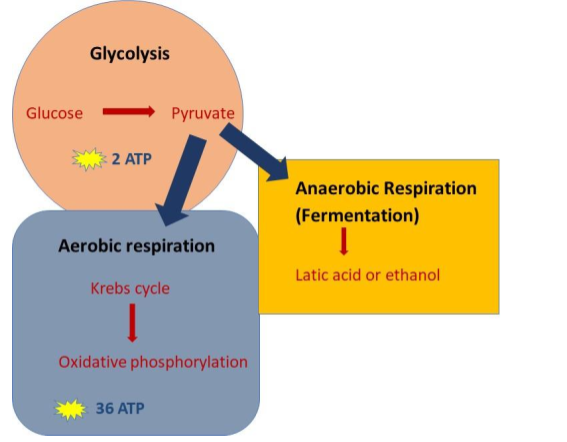
“Apart from Glucose, other Biomolecules can enter Cellular Respiration, including the building blocks of DNA and RNA”
While glucose is the most commonly used organic molecule for cellular respiration, other molecules can also be used as fuel.
- Fatty acids: In times of low glucose availability, the body can switch to using alternative energy sources such as fatty acids. Fatty acids can be broken down via beta-oxidation and enter cellular respiration via the citric acid cycle pathway as acetyl-CoA . The approximate ATP yield per fatty acid molecule is ~120 ATP molecules. This is based on the general notion that for every round of beta-oxidation, one molecule of acetyl-CoA is generated. Acetyl-CoA enters the citric acid cycle and produces 3 NADH molecules, 1 FADH 2 molecule, and 1 GTP (which later can be converted to ATP).
- Proteins: Proteins can be broken down into amino acids via proteolysis . If the amino acid is used as a fuel, it will first be stripped off of the amino group (deamination) to enter pathways (e.g., citric acid cycle and gluconeogenesis ). The breakdown of amino acids generates NADH and FADH 2 , which can contribute to ATP production through the ETC. The total ATP produced per protein (or per amino acid) will vary depending on the structural composition. On average, some amino acids (e.g., glutamate, aspartate, and arginine) have been estimated to produce about 7 to 10 ATP. Still, this can vary depending on the specific pathway involved and the cellular conditions.
- Nucleic Acids: DNA and RNA can be broken down into nucleotides to be metabolized into intermediates that can enter cellular respiration. Remember that nucleic acids are made up of nucleobases, phosphate groups, and pentose sugars. When degraded, the nucleotide releases pentose sugar (deoxyribose of DNA and ribose of RNA) that may enter different pathways. For instance, ribose-5-phosphate from the breakdown of a ribonucleotide (a building block of RNA) can enter the pentose phosphate pathway, an alternative pathway that eventually leads to the synthesis of glucose-6-phosphate, which can then enter glycolysis. Because of the complexity of the processes prior to the potential use of nucleotides as fuel for cellular respiration, the total ATP cannot be easily derived or estimated.
This flexibility in fuel utilization allows organisms to adapt to different metabolic conditions and energy demands.
Try to answer the quiz below and find out what you have learned so far about cellular respiration.
Choose the best answer.
Send Your Results (Optional)

Time is Up!
- Bonora, M., Patergnani, S., Rimessi, A., De Marchi, E., Suski, J. M., Bononi, A., Giorgi, C., Marchi, S., Missiroli, S., Poletti, F., Wieckowski, M. R., & Pinton, P. (2012). ATP synthesis and storage. Purinergic signalling, 8(3), 343–357. https://doi.org/10.1007/s11302-012-9305-8
- Britannica Editors. (2020) Sir Hans Adolf Krebs, German British Biochemist. Britannica. https://www.britannica.com/biography/Hans-Krebs
- Cox, S.E. (2013). Energy Metabolism. Encyclopedia of Human Nutrition. (3) 177-185.
- Dautant, A., et al. (2018). ATP synthases diseases of mitochondrial genetic origin. Frontiers in Physiology. (9) 329. https://doi.org/10.3389/fphys.2018.00329
©BiologyOnline.com. Content provided and moderated by BiologyOnline Editors.
Last updated on June 28th, 2023
You will also like...
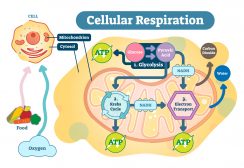
Cell Respiration
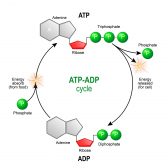
ATP & ADP – Biological Energy
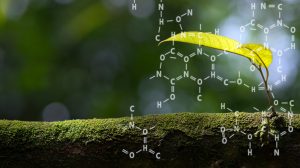
Effect of Chemicals on Growth & Development in Organisms
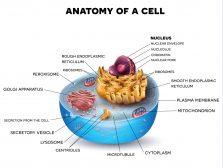
Biological Cell Introduction

Water in Plants
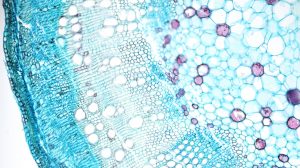
Cell Biology
Related articles....

An introduction to Homeostasis
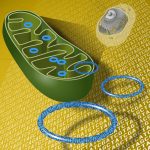
Prokaryotic Ancestor of Mitochondria: on the hunt

Mitochondrial DNA – hallmark of psychological stress

Mitochondrial DNA not just from moms but also from dads?
8.3 Cellular Respiration
Learning objectives.
By the end of this section, you will be able to:
- Compare and contrast the electron transport system location and function in a prokaryotic cell and a eukaryotic cell
- Compare and contrast the differences between substrate-level and oxidative phosphorylation
- Explain the relationship between chemiosmosis and proton motive force
- Describe the function and location of ATP synthase in a prokaryotic versus eukaryotic cell
- Compare and contrast aerobic and anaerobic respiration
We have just discussed two pathways in glucose catabolism—glycolysis and the Krebs cycle—that generate ATP by substrate-level phosphorylation. Most ATP, however, is generated during a separate process called oxidative phosphorylation , which occurs during cellular respiration. Cellular respiration begins when electrons are transferred from NADH and FADH 2 —made in glycolysis, the transition reaction, and the Krebs cycle—through a series of chemical reactions to a final inorganic electron acceptor (either oxygen in aerobic respiration or non-oxygen inorganic molecules in anaerobic respiration). These electron transfers take place on the inner part of the cell membrane of prokaryotic cells or in specialized protein complexes in the inner membrane of the mitochondria of eukaryotic cells. The energy of the electrons is harvested to generate an electrochemical gradient across the membrane, which is used to make ATP by oxidative phosphorylation.
Electron Transport System
The electron transport system (ETS) is the last component involved in the process of cellular respiration; it comprises a series of membrane-associated protein complexes and associated mobile accessory electron carriers ( Figure 8.15 ). Electron transport is a series of chemical reactions that resembles a bucket brigade in that electrons from NADH and FADH 2 are passed rapidly from one ETS electron carrier to the next. These carriers can pass electrons along in the ETS because of their redox potential . For a protein or chemical to accept electrons, it must have a more positive redox potential than the electron donor. Therefore, electrons move from electron carriers with more negative redox potential to those with more positive redox potential. The four major classes of electron carriers involved in both eukaryotic and prokaryotic electron transport systems are the cytochrome s, flavoprotein s, iron-sulfur protein s, and the quinone s.
In aerobic respiration , the final electron acceptor (i.e., the one having the most positive redox potential) at the end of the ETS is an oxygen molecule (O 2 ) that becomes reduced to water (H 2 O) by the final ETS carrier. This electron carrier, cytochrome oxidase , differs between bacterial types and can be used to differentiate closely related bacteria for diagnoses. For example, the gram-negative opportunist Pseudomonas aeruginosa and the gram-negative cholera-causing Vibrio cholerae use cytochrome c oxidase, which can be detected by the oxidase test, whereas other gram-negative Enterobacteriaceae, like E. coli , are negative for this test because they produce different cytochrome oxidase types.
There are many circumstances under which aerobic respiration is not possible, including any one or more of the following:
- The cell lacks genes encoding an appropriate cytochrome oxidase for transferring electrons to oxygen at the end of the electron transport system.
- The cell lacks genes encoding enzymes to minimize the severely damaging effects of dangerous oxygen radicals produced during aerobic respiration, such as hydrogen peroxide (H 2 O 2 ) or superoxide ( O 2 – ) . ( O 2 – ) .
- The cell lacks a sufficient amount of oxygen to carry out aerobic respiration.
One possible alternative to aerobic respiration is anaerobic respiration , using an inorganic molecule other than oxygen as a final electron acceptor. There are many types of anaerobic respiration found in bacteria and archaea. Denitrifiers are important soil bacteria that use nitrate ( NO 3 – ) ( NO 3 – ) and nitrite ( NO 2 – ) ( NO 2 – ) as final electron acceptors, producing nitrogen gas (N 2 ). Many aerobically respiring bacteria, including E. coli , switch to using nitrate as a final electron acceptor and producing nitrite when oxygen levels have been depleted.
Microbes using anaerobic respiration commonly have an intact Krebs cycle, so these organisms can access the energy of the NADH and FADH 2 molecules formed. However, anaerobic respirers use altered ETS carriers encoded by their genomes, including distinct complexes for electron transfer to their final electron acceptors. Smaller electrochemical gradients are generated from these electron transfer systems, so less ATP is formed through anaerobic respiration.

Check Your Understanding
- Do both aerobic respiration and anaerobic respiration use an electron transport chain?
Chemiosmosis, Proton Motive Force, and Oxidative Phosphorylation
In each transfer of an electron through the ETS, the electron loses energy, but with some transfers, the energy is stored as potential energy by using it to pump hydrogen ions (H + ) across a membrane. In prokaryotic cells, H + is pumped to the outside of the cytoplasmic membrane (called the periplasmic space in gram-negative and gram-positive bacteria), and in eukaryotic cells, they are pumped from the mitochondrial matrix across the inner mitochondrial membrane into the intermembrane space. There is an uneven distribution of H + across the membrane that establishes an electrochemical gradient because H + ions are positively charged (electrical) and there is a higher concentration (chemical) on one side of the membrane. This electrochemical gradient formed by the accumulation of H + (also known as a proton) on one side of the membrane compared with the other is referred to as the proton motive force (PMF). Because the ions involved are H + , a pH gradient is also established, with the side of the membrane having the higher concentration of H + being more acidic. Beyond the use of the PMF to make ATP, as discussed in this chapter, the PMF can also be used to drive other energetically unfavorable processes, including nutrient transport and flagella rotation for motility.
The potential energy of this electrochemical gradient generated by the ETS causes the H + to diffuse across a membrane (the plasma membrane in prokaryotic cells and the inner membrane in mitochondria in eukaryotic cells). This flow of hydrogen ions across the membrane, called chemiosmosis , must occur through a channel in the membrane via a membrane-bound enzyme complex called ATP synthase ( Figure 8.15 ). The tendency for movement in this way is much like water accumulated on one side of a dam, moving through the dam when opened. ATP synthase (like a combination of the intake and generator of a hydroelectric dam) is a complex protein that acts as a tiny generator, turning by the force of the H + diffusing through the enzyme, down their electrochemical gradient from where there are many mutually repelling H + to where there are fewer H + . In prokaryotic cells, H + flows from the outside of the cytoplasmic membrane into the cytoplasm, whereas in eukaryotic mitochondria, H + flows from the intermembrane space to the mitochondrial matrix. The turning of the parts of this molecular machine regenerates ATP from ADP and inorganic phosphate (P i ) by oxidative phosphorylation , a second mechanism for making ATP that harvests the potential energy stored within an electrochemical gradient.
The number of ATP molecules generated from the catabolism of glucose varies. For example, the number of hydrogen ions that the electron transport system complexes can pump through the membrane varies between different species of organisms. In aerobic respiration in mitochondria, the passage of electrons from one molecule of NADH generates enough proton motive force to make three ATP molecules by oxidative phosphorylation, whereas the passage of electrons from one molecule of FADH 2 generates enough proton motive force to make only two ATP molecules. Thus, the 10 NADH molecules made per glucose during glycolysis, the transition reaction, and the Krebs cycle carry enough energy to make 30 ATP molecules, whereas the two FADH 2 molecules made per glucose during these processes provide enough energy to make four ATP molecules. Overall, the theoretical maximum yield of ATP made during the complete aerobic respiration of glucose is 38 molecules, with four being made by substrate-level phosphorylation and 34 being made by oxidative phosphorylation ( Figure 8.16 ). In reality, the total ATP yield is usually less, ranging from one to 34 ATP molecules, depending on whether the cell is using aerobic respiration or anaerobic respiration; in eukaryotic cells, some energy is expended to transport intermediates from the cytoplasm into the mitochondria, affecting ATP yield.
Figure 8.16 summarizes the theoretical maximum yields of ATP from various processes during the complete aerobic respiration of one glucose molecule.
- What are the functions of the proton motive force?
As an Amazon Associate we earn from qualifying purchases.
This book may not be used in the training of large language models or otherwise be ingested into large language models or generative AI offerings without OpenStax's permission.
Want to cite, share, or modify this book? This book uses the Creative Commons Attribution License and you must attribute OpenStax.
Access for free at https://openstax.org/books/microbiology/pages/1-introduction
- Authors: Nina Parker, Mark Schneegurt, Anh-Hue Thi Tu, Philip Lister, Brian M. Forster
- Publisher/website: OpenStax
- Book title: Microbiology
- Publication date: Nov 1, 2016
- Location: Houston, Texas
- Book URL: https://openstax.org/books/microbiology/pages/1-introduction
- Section URL: https://openstax.org/books/microbiology/pages/8-3-cellular-respiration
© Jan 10, 2024 OpenStax. Textbook content produced by OpenStax is licensed under a Creative Commons Attribution License . The OpenStax name, OpenStax logo, OpenStax book covers, OpenStax CNX name, and OpenStax CNX logo are not subject to the Creative Commons license and may not be reproduced without the prior and express written consent of Rice University.

- school Campus Bookshelves
- menu_book Bookshelves
- perm_media Learning Objects
- login Login
- how_to_reg Request Instructor Account
- hub Instructor Commons
- Download Page (PDF)
- Download Full Book (PDF)
- Periodic Table
- Physics Constants
- Scientific Calculator
- Reference & Cite
- Tools expand_more
- Readability
selected template will load here
This action is not available.

2.26: Cellular Respiration
- Last updated
- Save as PDF
- Page ID 6472
Stages of Cellular Respiration
Cellular respiration involves many chemical reactions. The reactions can be summed up in this equation:
C 6 H 12 O 6 + 6O 2 → 6CO 2 + 6H 2 O + Chemical Energy (in ATP)
The reactions of cellular respiration can be grouped into three stages: glycolysis (stage 1), the Krebs cycle , also called the citric acid cycle (stage 2), and electron transport (stage 3). Figure below gives an overview of these three stages, which are further discussed in the concepts that follow. Glycolysis occurs in the cytosol of the cell and does not require oxygen, whereas the Krebs cycle and electron transport occur in the mitochondria and do require oxygen.
Cellular respiration takes place in the stages shown here. The process begins with a molecule of glucose, which has six carbon atoms. What happens to each of these atoms of carbon?
Structure of the Mitochondrion: Key to Aerobic Respiration
The structure of the mitochondrion is key to the process of aerobic (in the presence of oxygen) cellular respiration, especially the Krebs cycle and electron transport. A diagram of a mitochondrion is shown in Figure below .
The structure of a mitochondrion is defined by an inner and outer membrane. This structure plays an important role in aerobic respiration.
As you can see from Figure above , a mitochondrion has an inner and outer membrane. The space between the inner and outer membrane is called the intermembrane space. The space enclosed by the inner membrane is called the matrix. The second stage of cellular respiration, the Krebs cycle, takes place in the matrix. The third stage, electron transport, takes place on the inner membrane.
- Cellular respiration takes the energy stored in glucose and transfers it to ATP.
- Cellular respiration has three stages: glycolysis: the Krebs cycle and electron transport.
- The inner and outer membranes of the mitochondrion play an important roles in aerobic respiration.
Explore More
Explore more i.
Use this resource to answer the questions that follow.
- Cellular Respiration at http ://www.biologycorner.com/APbiology/cellular/notes_cellular_respiration.html .
- What are the three stages of cellular respiration?
- What is the outcome of glycolysis?
- What is produced during the Krebs cycle?
- What occurs during the electron transport system?
Explore More II
- Cellular Respiration at http://www.concord.org/activities/cellular-respiration .
- Define cellular respiration.
- Describe the structure of the mitochondrion and discuss the importance of this structure in cellular respiration.
- Assume that a new species of organism has been discovered. Scientists have observed its cells under a microscope and determined that they lack mitochondria. What type of cellular respiration would you predict that the new species uses? Explain your prediction.
- When you exhale onto a cold window pane, water vapor in your breath condenses on the glass. Where does the water vapor come from?
Essay About Cellular Respiration

Cellular Respiration And Interdeynthesis And Cellular Respiration
Cellular respiration and photosynthesis are critical in the continued cycle of energy to sustain life as we define it. Both have several stages in which the creation of energy occurs, and have varied relationships with organelles located within the eukaryotic cell. The processes are the key in how life has evolved and become as diverse as we know it. Although cellular respiration and photosynthesis have different processes, they are interdependent upon each other, while exhibiting complementary cycles
Cellular Respiration
Chapter 9 Cellular Respiration — Objectives — Equation for Cellular Respiration — Electron Carriers and Redox Reactions — Process of Cell Respiration — Glycolysis — Prep Reaction — Krebs Cycle (Citric Acid Cycle) — Electron Transport Chain — Fermentation — The Ingredients — You already know what is needed for Cellular Respiration Food + Oxygen Carbon Dioxide+ Water +ENERGY! C6H12O6 + O2 CO2 +H2O + ATP — Redox Reactions (the shuffling
t The purpose of this lab is to observe carbon dioxide being produced during an anaerobic respiration. Students will understand the effects of inhibitors. During the experiment for Mitosis, students should understand the different stages of mitosis and the cell cycle. They should be able to observe the stages of mitosis in the experiment. Cellular respiration releases energy as organic molecules are oxidized. ATP or Adenosine triphosphate is where this energy is stored. Cells need ATP to metabolize
Respiration is defined as the process of taking air into the body. Cellular respiration is much more complex. An organism consists of a single cell and even while a humans body contain trillions, all cells undergo cellular respiration. It also is by this process of breaking down food molecules which are simple sugars that produces the energy currency of the cell, also known as Adenosine Triphosphate (ATP). The way that photosynthesis works is by capturing light energy. This energy is captured in
A Study On Cellular Respiration
1. Define the following terms: a. Cellular respiration (aerobic respiration) (2 points) – the process of oxidizing food molecules to carbon dioxide and water. Glucose is an example. b. Fermentation (anaerobic respiration) (2 points)- metabolic process that converts sugar to acids, gas, or alcohol. 2. Summarize what occurs during the three steps of cellular respiration and indicate where each process takes place in the cell. (6 points) a. Glycolysis: occurs in the cytoplasmic fluid of the cell,
The Importance Of Cellular Respiration
¬¬Aldo San Pedro BIO 196-2023 Sharma October 30 2017 Writing Assignment #2 Cellular Respiration is one of the most important biochemical reactions. Through a serious of reactions, it is how we get energy from the foods we eat. First in this reaction pathway is glycolysis, or the oxidation of glucose, which occurs in the cytosol in both prokaryotes and eukaryotes. Glucose, a monosaccharide derived from the food we eat, is oxidized into 2 intermediate molecules named
Cellular Respiration Paper
Cellular respiration is used for the production of energy and the removal of waste products. The two types of cellular respiration are aerobic respiration, in which oxygen is used and anaerobic respiration, in which oxygen is not needed. (Jasuja et al, 2013). Aerobic respiration is used in every cell but anaerobic respiration is usually used in prokaryotic cells. Both take place in the mitochondria and cytoplasm and have 3 stages of respiration; glycolysis, Krebs cycle and electron transport chain
Cellular Respiration Lab
The purpose of the Cellular Respiration lab was to identify if cellular respiration is sped up due to exercise. To conduct the experiment each student filled a beaker with 15 ml of water and three drops of bromothymol blue. Next each student blew into the beaker through a straw until the water mix turns yellow. When carbon dioxide is added too bromothymol blue it changes to a yellow color. Each student times how long it takes for the water to turn yellow, records the data, and then reset the lab
Synthesis Of Cellular Respiration
Introduction Cellular respiration is a vital process that breaks down glucose to create energy. It takes place in aerobic organisms, meaning they require oxygen. The first step in this process is glycolysis where the breakdown of glucose occurs. After this oxidation of the glucose molecule, it becomes a pyruvate, generating 2 ATP and gives away two electrons that convert NADs to NADHs. The pyruvate then enters the mitochondria where it is transformed into acetyl CoA by oxidizing one of the carbons
ATP And Cellular Respiration
coenzyme that cells use to store energy. Also ATP is present in all cell's cytoplasm and nucleus as well because it’s vital for proper life functions in plants and animals. 2-) How many ATP molecules are produced by Cellular Respiration and by Fermentation? By Cellular Respiration there are 38 molecules that can be made per oxidized glucose molecule: 2 from the Krebs cycle, 2 from glycolysis, and an average of 34 from the electron transport system. On the other hand Fermentation is less efficient
Popular Topics
- Censorship Essay
- Cerebral Palsy Essay
- Ceremony Essay
- Cervical Cancer Essay
- Cesar Chavez Essay
- Chainsaw Massacre Essay
- Change Management Essay
- Changed America Essay
- Chaos Essay
- Character Reference Letters Essay
A Level Biology
Instant Access to A Level Biology Revision
Sign up now to get access to the entire library of a level biology resources for all exam boards.
If you're ready to pass your A-Level Biology exams, become a member now to get complete access to our entire library of revision materials.
Join over 22,000 learners who have passed their exams thanks to us!
Sign up below to get instant access!
Or try a sample...
Not ready to purchase the revision kit yet? No problem. If you want to see what we offer before purchasing, we have a free membership with sample revision materials.
Signup as a free member below and you'll be brought back to this page to try the sample materials before you buy.
An Introduction to Cellular Respiration
Nad+/fad and the importance of redox reactions, summary of the process of respiration, what is cellular respiration, what are 3 examples of anaerobic respiration, what are the types of cellular respiration, which organelle is essential for aerobic respiration, references and further reading.
- Respiration describes the mechanism by which cells break down food into usable cellular energy
- ATP is the key molecule in this process, where it acts as a currency for cellular energy
- Respiration consists of 4 steps: glycolysis, pyruvate oxidation, the Kreb’s cycle and the electron transport chain.
- Aerobic respiration occurs when oxygen is present and is efficient in producing cellular energy, anaerobic respiration occurs when the cell lacks an oxygen supply, and is not as efficient at generating cellular energy.
Respiration is the process of breaking down organic molecules to harvest chemical energy . For organisms such as humans, it involves taking in food, breaking it down, and turning into useful energy that our cells can use to perform many tasks. This is most efficiently done in the presence of oxygen to make an important molecule called ATP (adenosine triphosphate).
Glucose is the compound most often used to generate cellular energy. During cellular respiration, a glucose molecule is completely oxidised , releasing high energy electrons. The glucose molecule itself is broken down into carbon dioxide and water, and during this process, ATP is produced. ATP is a very important molecule in the process of respiration.
What is ATP?
ATP is the principal molecule for storing and transferring energy in cells, often known as the “molecular currency” of energy transfer. ATP is a small molecule with 3 phosphate groups attached to an adenosine molecule. ATP can be used to store energy for future reactions and can provide an immediate source of energy for reactions needed by the cell. Animals store the energy obtained from the breakdown of food as ATP.
ATP generates energy when it is broken down. When one of the phosphate groups is removed in a process called hydrolysis , ATP is converted to adenosine diphosphate ( ADP ) and energy is released. Energy is also released when a second phosphate is removed from ADP to form adenosine monophosphate ( AMP ). The release of this energy can be used to facilitate chemical reactions in the cell.
NAD+ (nicotinamide adenine dinucleotide) and FAD (flavin adenine dinucleotide).are other important molecules in the process of cellular respiration, acting as important electron carriers. Electron carriers are small organic molecules that play key roles in cellular respiration, where they shuttle electrons between molecules.
There are two types of electron carriers that are particularly important in the process of respiration: NAD+ and FAD. When NAD+ and FAD pick up electrons, they also gain one or more hydrogen atoms, switching to a slightly different form ( NADH and FADH2 ), and when they lose electrons, they go back to their original form. The reactions in which NAD+ FAD gain or lose electrons are examples of a class of reactions called redox reactions , which refers to reactions involving electron transfer. Cellular respiration involves many of these reactions.
Respiration is a four stage process, consisting of glycolysis, pyruvate oxidation, the Kreb’s cycle and the electron transport chain.
Glycolysis occurs in the cytoplasm, converting a glucose sugar into two 3 carbon molecules called pyruvate . A net of 2 molecules of ATP, 2 molecules of pyruvate, and 2 molecules of NADH are produced during the reaction. When oxygen is present, the pyruvate and NADH enter the mitochondria, and the next stage can begin.
The next stage involves the movement of pyruvate into the mitochondria where it is oxidised and converted into Acetyl-CoA . In this process of pyruvate oxidation , electrons are transferred to NAD+ , making NADH, and a carbon is lost, forming carbon dioxide .
The next stage is called the Citric Acid Cycle or the Kreb’s Cycle , which takes place in the mitochondrial matrix . It completes the breakdown of glucose by oxidising acetyl-coA to carbon dioxide . Acetyl-CoA binds to the starting compounds in the cycle, and through series of redox reactions , all carbons, hydrogens and oxygens in pyruvate ultimately end up as carbon dioxide and water. 8 NADH, 2 FADH2, 2 ATP and 6 CO2 are produced for each glucose molecule at this stage of cellular respiration.
The NADH and FADH2 go to the next stage, the electron transport chain . This chain consists of a series of membrane bound carriers in the inner membrane of the mitochondria that pass electrons from one acceptor to another. As the electrons are transferred, the cell is able to capture the energy produced to generate ATP . Oxygen acts as the terminal electron acceptor, and is reduced to form water, a by-product of the respiration reaction.
All of the high energy carriers from previous stages bring their electrons into the electron transport chain. The bulk of energy generated during cellular respiration is produced here, up to 38 molecules of ATP.
Aerobic and anaerobic respiration
Cellular respiration refers to both aerobic and anaerobic respiration , but is often synonymous with aerobic respiration. Both aerobic and anaerobic respiration involve chemical reactions which take place in the cell to produce energy, which is needed for active processes. Aerobic respiration requires oxygen to fully oxidise the organic molecule. This releases lots of energy. Anaerobic respiration involves the breakdown of glucose without oxygen. This releases much less energy. Anaerobic respiration is useful in tissues which have a high energy demand such as in muscles, in which there is not enough oxygen to produce all the energy needed by using aerobic respiration alone. Anaerobic respiration takes place in the cell cytoplasm and produces lactic acid .
Frequently Asked Questions
Cellular respiration is a set of biochemical reactions in which the body’s metabolic fuel is oxidized and the energy thus released is used to generate ATP.
The 3 examples of anaerobic respiration include lactic acid fermentation, alcoholic fermentation, and decomposition of the organic matter by decomposers.
Cellular respiration is classified into two types; aerobic and anaerobic respiration. The complete oxidation of glucose in the presence of oxygen is called aerobic respiration, while respiration in the absence of oxygen is anaerobic..
Mitochondria is essential for aerobic respiration to take place.
https://www.philpoteducation.com/mod/book/view.php?id=835&chapterid=1159#/ Image cellular respiration
https://www.nature.com/scitable/ebooks/essentials-of-cell-biology-14749010/122996679
Campbell, Neil A., and Jane B. Reece. Biology (8th Edition). San Francisco: Benjamin Cummings, 2007.
Similarities and Differences of Photosynthesis and Cellular Respiration Definition Essay
Photosynthesis and cellular respiration are energy reactions occurring in plant and animal cells. During photosynthesis, oxygen and glucose are produced from sunlight, water, and carbon dioxide. During cellular respiration, oxygen and glucose are used to create water, carbon dioxide and ATP. Both processes constitute the energy cycle required for organisms to function. The purpose of this paper is to analyze cellular respiration and photosynthesis and establish their similarities and differences.
Photosynthesis is the process in green plants that transforms solar radiation into energy that plants use for development and growth. It is basically a complex chemical reaction that happens inside the leaves of a plant, aimed to produce food for it to survive (Govindjee et al., 2018). The starting reactants are the light of the sun, carbon dioxide, and water. They get into the plant from the sun, air, and ground respectively. Photosynthesis occurs in chloroplasts in two stages: light-dependent reactions and the Calvin cycle.
During the first stage, chloroplasts capture sunlight and use it to form the molecules of ATP and NADPH. During the second stage, called the Calvin cycle, the energy generated during the first stage is used to make carbohydrates (Blankenship, 2014). Contrary to the first stage, the reactions of the Calvin cycle can occur without light. The overall process can be described as following: six molecules of carbon dioxide and six water molecules are converted in the presence of light into glucose and six molecules of oxygen. Glucose is used as an energy source for the plant, while oxygen is released back into the air.
Cellular respiration is a set of reactions that converts glucose into adenosine triphosphate (ATP), an organic compound that provides energy to cells. The purpose of the process is to produce energy that organisms need to function (Russell et al., 2016). The initial reactants are oxygen and glucose, with glucose entering the body with food, and oxygen entering the body when breathing. During cellular respiration, a glucose molecule is split into ATP, carbon dioxide, and water. The reactions occur in mitochondria in four stages: “glycolysis, pyruvate oxidation, citric acid cycle, and oxidative phosphorylation” (Campbell & Paradise, 2016, p. 124). The overall reaction can be described as one molecule of glucose and six molecules of oxygen yielding six molecules of carbon dioxide, six water molecules, and 36–38 molecules of ATP (Campbell & Paradise, 2016). Carbon dioxide is transported to the lungs to be exhaled, and ATP is used in cellular work.
Both photosynthesis and cellular respiration are processes aimed at converting one form of energy into another. They both involve the same ingredients: water, oxygen, carbon dioxide, and glucose. However, the processes are opposite in their products and reactants. Cellular respiration takes oxygen from the air, while photosynthesis puts it back. Photosynthesis needs light to operate, while cellular respiration takes place both day and night in living cells.
The two processes complement each other in a mutually beneficial relationship. They are both a part of the cycle of biochemical reactions in which one type of energy is converted into another. Both processes are required to support the being of plants and animals. If one of them stops occurring, the other would also be unable to continue because it requires the energy produced by the other (Russell et al, 2016). They both constitute a cycle that sustains life on Earth.
Photosynthesis and cellular respiration are different processes that are connected to one another. They are two sides of the energy circulation process that supports the life of every living organism on the Earth (Treagust & Tsui, 2013). Photosynthesis produces energy for plants and releases oxygen that animals use to create ATP. In the production of ATP, carbon dioxide is released that is used by plants to make oxygen. In can be said that photosynthesis and cellular respiration form a cycle that provide energy necessary for all life on the Earth.
Blankenship, R. (2014). Molecular mechanisms of photosynthesis. John Wiley & Sons.
Campbell, M., & Paradise, C. (2016). Cellular respiration. Momentum Press.
Govindjee, Bjorn, L., & Shevela, D. (2018). Photosynthesis: Solar energy for life. World Scientific Publishing.
Russell, P., Hertz, P., & McMillan, B. (2016). Biology: The dynamic science. Cengage Learning.
Treagust, D., & Tsui, C. (2013). Multiple representations in biological education. Springer Science & Business Media.
- Chicago (A-D)
- Chicago (N-B)
IvyPanda. (2022, June 21). Similarities and Differences of Photosynthesis and Cellular Respiration. https://ivypanda.com/essays/photosynthesis-and-cellular-respiration-research/
"Similarities and Differences of Photosynthesis and Cellular Respiration." IvyPanda , 21 June 2022, ivypanda.com/essays/photosynthesis-and-cellular-respiration-research/.
IvyPanda . (2022) 'Similarities and Differences of Photosynthesis and Cellular Respiration'. 21 June.
IvyPanda . 2022. "Similarities and Differences of Photosynthesis and Cellular Respiration." June 21, 2022. https://ivypanda.com/essays/photosynthesis-and-cellular-respiration-research/.
1. IvyPanda . "Similarities and Differences of Photosynthesis and Cellular Respiration." June 21, 2022. https://ivypanda.com/essays/photosynthesis-and-cellular-respiration-research/.
Bibliography
IvyPanda . "Similarities and Differences of Photosynthesis and Cellular Respiration." June 21, 2022. https://ivypanda.com/essays/photosynthesis-and-cellular-respiration-research/.
- Chemical Evidence for a Prokaryotic Origin of Subcellular Organelles
- Photosynthesis Rate Determination From the Oxygen Gas Evolution
- Biology: Photosynthesis and Respiration
- The Complexity of Photosynthesis and Respiration
- Planting Bamboo: The Role of Photosynthesis
- Anaerobic Respiration and Its Applications
- Runaway Photosynthesis and Its Effects on Life in the Universe
- Cellular Respiration in Context of Human Biology
- Cell Energy Metabolism Controls
- Recent Advances in Artificial Photosynthesis
- Punctuated Equilibrium: Arguments for and Against
- Aspects of Biology Techniques
- Shapes of Cells and Their Functions
- From the Chemical Components to the Whole Body
- The Effect of Habitat Disturbance on Invertebrate Abundance and Diversity

- Environment
- Information Science
- Social Issues
- Argumentative
- Cause and Effect
- Classification
- Compare and Contrast
- Descriptive
- Exemplification
- Informative
- Controversial
- Exploratory
- What Is an Essay
- Length of an Essay
- Generate Ideas
- Types of Essays
- Structuring an Essay
- Outline For Essay
- Essay Introduction
- Thesis Statement
- Body of an Essay
- Writing a Conclusion
- Essay Writing Tips
- Drafting an Essay
- Revision Process
- Fix a Broken Essay
- Format of an Essay
- Essay Examples
- Essay Checklist
- Essay Writing Service
- Pay for Research Paper
- Write My Research Paper
- Write My Essay
- Custom Essay Writing Service
- Admission Essay Writing Service
- Pay for Essay
- Academic Ghostwriting
- Write My Book Report
- Case Study Writing Service
- Dissertation Writing Service
- Coursework Writing Service
- Lab Report Writing Service
- Do My Assignment
- Buy College Papers
- Capstone Project Writing Service
- Buy Research Paper
- Custom Essays for Sale
Can’t find a perfect paper?
- Free Essay Samples
Cellular Respiration Definition
Updated 17 March 2023
Subject Biology
Downloads 56
Category Science
Topic Cellular Respiration
Cellular Respiration
Cellular respiration is a series of metabolic processes that all living things use to convert energy stored in organic molecules, such as glucose. The process can seem complicated but is actually pretty straightforward.
Photosynthetic Producers
Plants and other photosynthetic producers (autotrophs) create glucose molecules by utilizing sunlight, water, and carbon dioxide to form a chemical bond between glucose and oxygen. These chemical bonds store energy, which organisms need to survive and reproduce.
Glucose as a Source of Energy
Glucose is the major source of cellular energy for all eukaryotic organisms, including humans! All eukaryotic organisms can catabolize glucose into energy-storing molecules called ATP and carbon dioxide.
Glycolysis is the first step in cellular respiration, and it occurs in all living cells, regardless of type. It does not require oxygen and is therefore anaerobic (processes that do require oxygen are called aerobic).
In this stage, a carboxyl group from the molecule of glucose is removed and replaced with a hydroxyl group; then it is oxidized to an acetyl group. This acetyl group is picked up by NAD+, forming NADH, which then picks up the high-energy electrons to generate ATP.
The Citric Acid Cycle
The citric acid cycle or the Krebs cycle is the second pathway in cellular respiration. This pathway takes place in the mitochondria. It produces a net gain of CO2 and ATP, along with 3 NADH and 1 FADH2, each time it completes a turn.
This is a closed loop, so the cycle continues until all of the needed compounds are produced. The rate of this cycle is controlled by ATP concentration.
Oxidative Phosphorylation
Oxidative phosphorylation is the final stage in cellular respiration, and it occurs on the inner mitochondrial membrane. This is an anaerobic pathway, which means it does not require oxygen; however, it can still occur in the presence of extraneous oxygen.
During oxidative phosphorylation, protons are diffused from the outer mitochondrial membrane into the mitochondrial matrix to bind with cytochrome c, producing two NADH and one FADH2. This redox reaction transfers the energy from NADH and FADH2 to as many as 34 more ATP molecules.
These ATP molecules can then power a variety of reactions throughout the body. They also help cells withstand the effects of stress, such as a cold or a fever.
Biochemical Steps and Redox Reactions
Cellular respiration involves a series of biochemical steps, most of which are redox reactions. These redox reactions break down large molecules into smaller ones, releasing their free energy as ATP.
Redox Reactions of Cellular Respiration
The three redox reactions involved in cellular respiration include glycolysis, transformation of pyruvate, and the citric acid cycle. They are controlled by enzymes called phosphofructokinases, pyruvate dehydrogenases, and isocitrate dehydrogenases.
Each molecule of glucose undergoes a series of carefully controlled redox reactions to break down its chemical bonds and release its free energy as ATP. The reactions are controlled by rate-determining enzymes.
Location and Importance of Cellular Respiration
The reactions of cellular respiration take place in the cytoplasm and mitochondria of all cells, and they involve the oxidation of nutrients to produce ATP. These reactions are the most common and important ones of all because they sustain life by transferring energy to other biological molecules that carry out cellular functions.
Deadline is approaching?
Wait no more. Let us write you an essay from scratch
Related Essays
Related topics.
Find Out the Cost of Your Paper
Type your email
By clicking “Submit”, you agree to our Terms of Use and Privacy policy. Sometimes you will receive account related emails.

IMAGES
VIDEO
COMMENTS
Cellular respiration is the process through which cells convert sugars into energy. To create ATP and other forms of energy to power cellular reactions, cells require fuel and an electron acceptor which drives the chemical process of turning energy into a useable form. Cellular Respiration Overview. , including all multicellular organisms and ...
cellular respiration, the process by which organisms combine oxygen with foodstuff molecules, diverting the chemical energy in these substances into life-sustaining activities and discarding, as waste products, carbon dioxide and water. Organisms that do not depend on oxygen degrade foodstuffs in a process called fermentation.
Cellular respiration is a series of metabolic processes that take place within a cell in which the biochemical energy is harvested from an organic substance (e.g. glucose) and then stored in an energy-carrying biomolecule (e.g. ATP) for use in energy-requiring activities of the cell. Synonyms: cell respiration.
Cellular respiration is a series of chemical reactions that break down glucose to produce ATP, which may be used as energy to power many reactions throughout the body. There are three main steps of cellular respiration: glycolysis, the citric acid cycle, and oxidative phosphorylation. Glycolysis takes place in the cytosol, the citric acid cycle ...
The space enclosed by the inner membrane is called the matrix. The second stage of cellular respiration, the Krebs cycle, takes place in the matrix. The third stage, electron transport, takes place on the inner membrane. Figure 5.9.6 5.9. 6: The structure of a mitochondrion is defined by an inner and outer membrane.
Respiration begins at the nose or mouth, where oxygenated air is brought in before moving down the pharynx, larynx, and the trachea.The trachea branches into two bronchi, each leading into a lung.Each bronchus divides into smaller bronchi, and again into even smaller tubes called bronchioles.At the end of the bronchioles are air sacs called alveoli, and this is where gas exchange occurs.
Cellular respiration is a process that happens inside an organism's cells. This process releases energy that can be used by the organism to live and grow. Many food molecules are broken down into glucose, a simple sugar. Glucose is used in cellular respiration. Glucose and oxygen are inputs of cellular respiration.
Cellular respiration is a set of metabolic reactions and processes that take place in the cells of organisms to convert biochemical energy from nutrients into ATP, and then release waste products. The reactions involved in respiration are catabolic reactions, which break large molecules into smaller ones, releasing energy in the process. ...
Cellular respiration. Cellular respiration is a biochemical process of breaking down food, usually glucose, into simpler substances. The energy released in this process is tapped by the cell to drive various energy-requiring processes. Cellular respiration can occur both aerobically (using oxygen), or anaerobically (without oxygen).
The electron transport system (ETS) is the last component involved in the process of cellular respiration; it comprises a series of membrane-associated protein complexes and associated mobile accessory electron carriers ( Figure 8.15 ). Electron transport is a series of chemical reactions that resembles a bucket brigade in that electrons from ...
Aerobic cellular respiration is the most common form of cellular respiration in eukaryotic cells. It involves three major stages or series of reactions, which are called (1) glycolysis, (2) the ...
Cellular respiration is the process of which biological fuels are oxidised in the presence of an inorganic electron acceptor such as oxygen to produce large amounts of energy, to drive the bulk production of ATP. Anaerobic respiration is used by microorganisms either bacteria or archaea in which neither oxygen (aerobic respiration) nor pyruvate ...
Stages of Cellular Respiration. Cellular respiration involves many chemical reactions. The reactions can be summed up in this equation: C 6 H 12 O 6 + 6O 2 → 6CO 2 + 6H 2 O + Chemical Energy (in ATP). The reactions of cellular respiration can be grouped into three stages: glycolysis (stage 1), the Krebs cycle, also called the citric acid cycle (stage 2), and electron transport (stage 3).
Pyruvate oxidation and the citric acid cycle. Glycolysis can extract a bit of the energy from a glucose molecule, but the citric acid cycle can squeeze out much more. Learn about the steps of the cycle, how it harvests energy, and how it's fueled by acetyl CoA (produced by oxidation of pyruvate from glycolysis).
1. Define the following terms: a. Cellular respiration (aerobic respiration) (2 points) - the process of oxidizing food molecules to carbon dioxide and water. Glucose is an example. b. Fermentation (anaerobic respiration) (2 points)- metabolic process that converts sugar to acids, gas, or alcohol. 2.
Cellular respiration is a chemical reaction in which glucose is broken down in the presence of oxygen, releasing chemical energy and producing carbon dioxide and water as waste products: glucose + oxygen → chemical energy + carbon dioxide + water. The energy released is captured in molecules of adenosine triphosphate, or ATP, which then ...
Cellular respiration is the process by which individual cells break down food molecules, such as glucose and release energy. This is because cellular respiration slowly releases the energy of glucose in a few small steps. It uses the energy released to form ATP molecules, which are the energy-carrying molecules that cells use to power ...
Cellular respiration is a set of biochemical reactions in which the body's metabolic fuel is oxidized and the energy thus released is used to generate ATP. What are 3 examples of anaerobic respiration? The 3 examples of anaerobic respiration include lactic acid fermentation, alcoholic fermentation, and decomposition of the organic matter by ...
Steps of cellular respiration. During cellular respiration, a glucose molecule is gradually broken down into carbon dioxide and water. Along the way, some ATP is produced directly in the reactions that transform glucose. Much more ATP, however, is produced later in a process called oxidative phosphorylation. Oxidative phosphorylation is powered ...
Without cellular respiration Gerald would be dead. The four steps of cellular respiration are Glycolysis, Acetyl CoA Formation, The Krebs Cycle, and The Electron Transport Chain. By following the electrons in cellular respiration we can understand how Gerald's apple, in part, gives him the energy to survive.
Both photosynthesis and cellular respiration are processes aimed at converting one form of energy into another. They both involve the same ingredients: water, oxygen, carbon dioxide, and glucose. However, the processes are opposite in their products and reactants. Cellular respiration takes oxygen from the air, while photosynthesis puts it back.
Meaning. Cellular respiration. The process by which organisms break down glucose into a form that the cell can use as energy. ATP. Adenosine triphosphate, the primary energy carrier in living things. Mitochondria. The eukaryotic cell structure where cellular respiration occurs. Cytoplasm. The contents of a cell between the plasma membrane and ...
Cellular respiration is a series of metabolic processes that all living things use to convert energy stored in organic molecules, such as glucos... 505 words. Read essay for free.